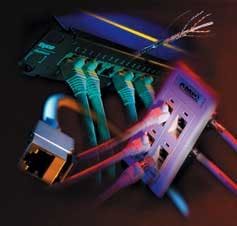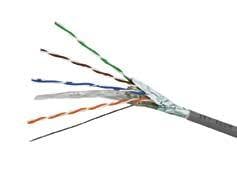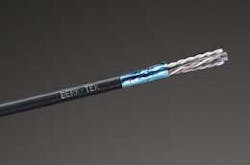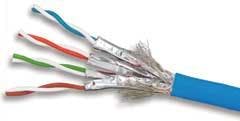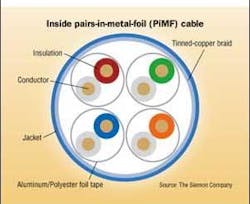Shielded twisted-pair cable boasts EMI fighting qualities
Throughout much of Europe, shielded copper cable is considered the better performing media, whereas in the United States and much of the world, UTP is the preferred choice. But with industrial environments moving to Ethernet, and a 10GBase-T standard in development, shielded cabling is now getting more attention in the U.S.
Obstacle course
In Germany, France, Switzerland, and Austria, shielded cable is the norm because it is believed to offer data networks much needed protecti on from electromagnetic interference (EMI) and alien crosstalk (ANEXT). In other parts of the world, UTP cable is considered the most cost-effective choice to meet the needs of most installations. "UTP cables provide immunity to noise through balance, where the noise is coupled onto both wires of a pair equally and the differential receiver can reject the noise that is common to both wires," explains Eric Lawrence, technical director, telecom NA, Berk-Tek/Nexans (www.berktek.com). "Depending on the type of shielding, shielded cables prevent noise from getting onto the signal wires by either reflecting or absorbing the noise."
In November, Tyco Electronics introduced the AMP Netconnect XG Copper Cabling System for 10-Gbit Ethernet applications, which consists of shielded cable, connectors, and patch panel designs built to overcome ANEXT to enable 10-Gbit Ethernet transmission over a full 100-meter channel.
Viewpoints vary on why shielded cable rules in Europe while UTP remains dominant in the U.S. One historical account blames the possible detrimental affects of electromagnetic fields, stating that while UTP is not illegal in Germany, insurance companies have refused coverage if workers ever require medical care due to EMI fields. Other accounts attribute the disparity to the introduction of Ethernet, overall performance, or even basic cultural differences.
"I have heard accounts that the reasoning behind this was because telecommunications cabling could be run in the same pathway as electrical cable, thus reducing the cost of the infrastructure," says Bob Zahr, RCDD/LAN Specialist and Systems Engineering Manager for Tyco Electronics (www.tycoelectronics.com). "The shielded cable would be immune to any electrical magnetic interference generated from the power cable located in the same pathway."
Historical accounts aside, a properly designed and installed shielded cabling system offers protection against EMI and, therefore, better signal integrity than UTP. Nevertheless, "fear and uncertainty when it comes to installing shielded cable has delayed its inception in the U.S.," says Harry Forbes, chief technology officer and cofounder of ITT Industries Network Systems and Services (www.ittnss.com). "One of the biggest obstacles deals with mass termination tools. Every installer carries a 110 or Krone tool, and trying to convince them all that they need to take on another tool for shielded is not an easy task."
While shielded cable proponents claim it can be installed just as quickly as UTP, the overall cost of implementing a shielded system has been estimated at 30 to 40 percent more than an equivalent UTP system because the product not being readily available. Zahr calls cost "the number one obstacle here in the U.S. Most contractors aren't familiar with it how to install it correctly either, so there's a learning curve that has to be overcome."
Some companies favoring UTP claim that an improperly installed or damaged shielded system can have an overall performance worse than Category 5. Degradation, they claim, mainly results from ground loops or current flowing along the shield at different potentials, which can introduce noise onto the wires-despite the shielding.
Forbes disagrees: "For the number of years that shielded has been installed, we've never come across any earthing problems. It's as simple as making sure the shield is properly grounded and bonded for equal potential."
Choice variety
Since there are several different types of shielding, you need to become familiar with several acronyms associated with shielded cable. While the term "shielded twisted pair" can be used to refer to any twisted pair cabling that contains shielding, the acronym STP refers mainly to the outdated IBM type cables used with Token Ring applications. This cable should not be confused with ScTP (screened twisted-pair) or FTP (foil twisted-pair) used with Ethernet networks and designed with pairs surrounded by a single foil or braided screen. "Although a true ScTP cable would have a braid rather than a foil around the four pair cables, ScTP and FTP are often used interchangeably," explains Zahr "An FTP cable is a four-pair cable that is basically a shielded version of the category UTP cables."
Berk-Tek offers a full line of shielded cables, including a dual-foil Category 6 and an end-to-end Category 7 solution that is backward compatible with Category 5e and 6 modular connectors.
Cable with pairs that are individually shielded is called PiMF (pairs in metal foil), which is also sometimes referred to as SSTP (double shield twisted-pair) cable. "PiMF cable usually contains an overall shield in addition to the shield on each pair-but not always," says Lawrence. "Because a shield surrounds each pair in the PiMF cable, it eliminates any issue with internal crosstalk." The ISO Category 7/Class F standard specifies PiMF to eliminate crosstalk between all pairs up to 600 MHz.
Industry professionals contacted by Cabling Installation & Maintenance do not foresee PiMF cabling becoming popular in the U.S. because of its larger diameter and time-consuming installation. Installers must strip off the outer jacket and overall shield, and then strip the shield off each individual pair.
Despite these challenges, Delray Medical Center (Delray Beach, FL) chose The Siemon Company's (www.siemon.com) TERA Category 7/Class F shielded system with PiMF 800 MHz cable for their new state-of-the-art imaging center. With each pair shielded and an overall braided shielding around the four pairs, each pair in the cable can run its own application without disruption to other pairs.
"We chose to deploy this type of shielded cabling system to protect the network data from EMI generated in the imaging center, and to have the throughput capacity to handle large-file transfer," says Cathy Christensen, IS director for Delray Medical Center. The Siemon Company says its cable is designed for high-bandwidth applications like digital imaging because all four pairs of the cable can transmit 10-Gbit Ethernet up to a full 100 meters with no worry about effects caused by internal or external noise.
To view the Shielded Cable Product Update, please click here.
Newfound needs
The Siemon Company's TERA Category7/Class F shielded system with PiMF 800 MHz cable is designed for high-bandwidth applications because all four pairs can transmit 10-Gbit Ethernet up to a full 100 meters with no worry about effects caused by internal or external noise.
As industrial environments move from conventional fieldbus systems to Ethernet, the U.S. market is experiencing a greater uptake of shielded cable to overcome problems with noise from machinery or other electronic equipment. "Industrial standards currently in development call out FTP cable as a viable option," says Zahr. "If someone is installing cable in a harsh environment, they should absolutely be putting in shielded."
Berk-Tek's Lawrence, however, warns that not every industrial noise problem can be solved with shielded cable. "Care must be taken in industrial environments that are so severe that even shielding isn't sufficient," he says. "In these cases, an optical-fiber solution may best." While many agree that shielded is better for industrial applications where machinery is becoming part of the network, the challenge of running 10-Gigabit Ethernet over copper is fueling the debate between shielded and unshielded cabling use.
The 10GBase-T (IEEE 802.3an) standard under development has identified ANEXT as the significant parameter limiting 10-Gbit Ethernet performance over a 100-meter channel. ANEXT is increased by the propensity of cables to absorb signals from neighboring cables in close proximity. The foil shielding in shielded cables greatly reduces the affects of ANEXT, making shielded much less vulnerable than UTP.
"Shielded solutions pose far less challenges in meeting 10-Gbit Ethernet standards because of their immunity to ANEXT," says Forbes. "We don't know if developments in UTP systems will meet expectations, but shielded cable achieves longer transmission distances because insertion loss to ANEXT ratio is better preserved."
ITT Network Systems and Services' ISCS XE provides more than 250 MHz of operational bandwidth to support Class E applications, while its ISCS 200 (formerly Gigapath) is specified to exceed the requirements of Category 5e and provide more than 200 MHz of operational bandwidth. "Customers expect performance, flexibility of design, robustness, and the ability to reach over longer distances," says Forbes. "Our shielded cabling systems meet those expectations, which is why our philosophy is prevention of ANEXT rather than cure."
ISO Category 7/Class F standard specifies PiMF, which is cable with pairs that are individually shielded to eliminate any issue with internal crosstalk.
Other manufacturers are taking a similar approach, promoting their shielded systems as a viable solution for 10-Gbit Ethernet. In November, Tyco Electronics introduced the AMP Netconnect XG Copper Cabling System for 10-Gbit Ethernet applications (www.ampnetconnect.com). This system consists of shielded cable, connectors, and patch panel designs built to overcome ANEXT to fully support the proposed 10GBase-T standard and enable 10-Gbit Ethernet transmission over a full 100-meter channel.
"According to Shannon's Law, which defines the theoretical maximum amount of data transmitted in the presence of noise, existing Category 6 UTP will likely be limited to channel lengths of less than 55 meters for 10-Gbit Ethernet due to alien crosstalk," says Zahr. "The fact is that today's standards-based network designs demand media that can support the full 100-meter distance for horizontal channels, and our shielded solution does just that for 10 Gig."
Berk-Tek also offers a full line of shielded cables, including a dual-foil Category 6 and an end-to-end Category 7 solution that is backward compatible to Category 5e and 6 modular connectors. "From a performance standpoint, shielded cable is an ideal solution and viable option for 10GBase-T," says Lawrence. "Of course, the solution needs to be properly installed and terminated, which in general, will increase the installation cost as compared to existing UTP solutions." Berk-Tek's GUARDmark-6 is a Category 6 FTP cable intended for high-speed data applications.
According to Forbes, ANEXT is not a new phenomenon: "As far back as the early '90s, the financial market was experiencing network problems due to unbalanced signals from analog video used in Reuters and Bloomberg switches. When an Ethernet network slows down, it is often thought to be caused by heavy traffic. But in many cases, it's because of ANEXT from adjacent cables swamping the data signals and causing retransmits, even at lower speeds."
Advantages ahead
While shielded cable faces many challenges to infiltrate markets outside of Europe, and cost remains the primary concern in the U.S., Zahr and others are increasingly seeing shielded cable chosen for industrial and high-speed applications. "Based on our presentat'ions and technical seminars where we have presented information on FTP versus UTP, customers have decided to install a shielded solution," says Zahr. "It's information that's being listened to and considered."
Berk-Tek's Lawrence anticipates the shielded cable market to grow as more structured cabling continues to penetrate into the industrial space. "In additional to industrial applications, as alien crosstalk and other external noises become critical for next-generation LAN cables, shielded cables will most likely become a larger niche within the U.S. market."
"We've tested systems side-by-side using the same applications, same equipment, and same level of traffic," says Forbes. "The shielded systems have outperformed UTP, and we have customers telling us that since they made the switch to shielded, they haven't had any problems with their network."
Says Zahr, "In an office environment, where they're not planning to migrate to 10 Gig, UTP is certainly adequate. But if a customer wants to put in something today that they can be certain not to have to remove in the next 10 years, a shielded system is it."
According to Zahr, the cost of implementing a shielded solution will decrease as product infiltrates the market. "The cost will come down once people become more familiar with shielded cable and as they realize it's the best solution for 10 Gig over copper."
BETSY ZIOBRON is a freelance writer covering the cabling industry, and a regular contributor to Cabling Installation & Maintenance. She can be reached at: [email protected]The information about Roxtec's firestopping products that appeared in our October issue (page 46) was incorrect. Roxtec provides round and rectangular mechanical firestop transits for walls, floors, and cabinets. The systems have 1-, 2-, 3-, 4-, and 6-hour fire ratings, and have achieved more than 160 certificates worldwide, including UL, ULC, FM, CSA, USN, USCG, ABS, DNV, and BVA. The company's products are watertight to depths of 50 feet and protect against fire, water, smoke/toxicity, shock/vibration, explosions/blasts, EMI, EMP, and EMC. They can support cables and accept future penetrations.
